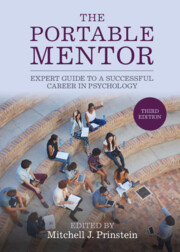Book contents
- The Portable Mentor
- The Portable Mentor
- Copyright page
- Dedication
- Contents
- Figures
- Tables
- Boxes
- Contributors
- Preface
- Acknowledgments
- Part I Applying to Graduate School
- Part II Beginning your Career
- Part III Your Research/Academic Career
- 11 An Open Science Workflow for More Credible, Rigorous Research
- 12 Presenting Your Research
- 13 Publishing Your Research
- 14 Recommendations for Teaching Psychology
- 15 Applying for NIH Grants
- 16 On Being a Woman in Academic Psychology
- Part IV Your Career as a Practitioner
- Part V Your Professional Service Career
- Part VI Your Career After Graduate School
- Index
- References
14 - Recommendations for Teaching Psychology
from Part III - Your Research/Academic Career
Published online by Cambridge University Press: 21 July 2022
- The Portable Mentor
- The Portable Mentor
- Copyright page
- Dedication
- Contents
- Figures
- Tables
- Boxes
- Contributors
- Preface
- Acknowledgments
- Part I Applying to Graduate School
- Part II Beginning your Career
- Part III Your Research/Academic Career
- 11 An Open Science Workflow for More Credible, Rigorous Research
- 12 Presenting Your Research
- 13 Publishing Your Research
- 14 Recommendations for Teaching Psychology
- 15 Applying for NIH Grants
- 16 On Being a Woman in Academic Psychology
- Part IV Your Career as a Practitioner
- Part V Your Professional Service Career
- Part VI Your Career After Graduate School
- Index
- References
Summary
The chapter provides guidance on course design and pedagogical practices that are essential, not only for effective teaching but also for making the case to hiring and promotion committees regarding your ability to reach to students and help them learn. The chapter introduces approaches that are inclusive and broad-minded in their choice and framing of content as well as in their classroom practices. Readers will also find guidance for practicing their craft on remote and hybrid teaching platforms.
Keywords
- Type
- Chapter
- Information
- The Portable MentorExpert Guide to a Successful Career in Psychology, pp. 266 - 283Publisher: Cambridge University PressPrint publication year: 2022



